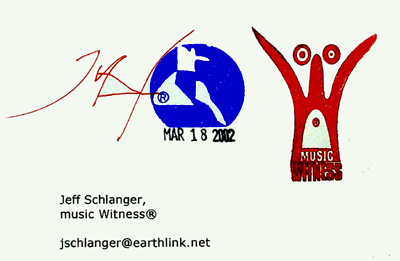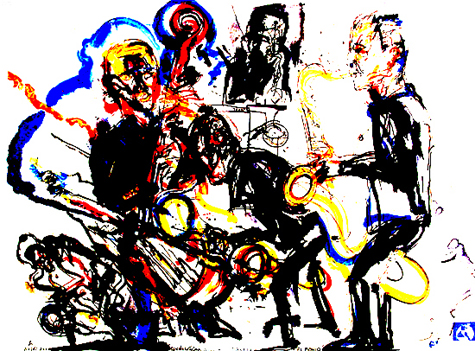
El Bohio (William Parker + Charles Gayle)—3 July 1987
This winter, on the Lower East Side, two beautifully built older structures
housing community cultural organizations, El Bohio and Cuando, are falling
to the forces of "development" after extended struggles by neighborhood
resisters. The destined replacements? Of course. High-priced condos and
a shopping mall.
The importance of these two centers as shelters for the manifestation
of creative music and neighborhood culture was deep and long. For one
instance, El Bohio on East 9th Street, a former school, was home in 1987
to the Jazz Art Expo, an early forerunner of the Vision Festival. The
large lobby glowed with a great variety of art including my 8-foot Julius
Hemphill column and the painting of the Billy Bang's Sextet Live used
on the cover of one of the last LP recordings Soul Note produced. These
were surrounded by a tremendous range of work by expressive visual artists
and photographers focused on music.
Upstairs, a long cavalcade of concerts was underway. In one classroom
you could hear the incendiary sound of Charles Gayle and William Parker
pouring it on together with a portrait of Trane on the wall between them.
Vibrations from that encounter continue to hang in the neighborhood air.
Both Stones were there in the audience as usual, listening to the leading
edge.
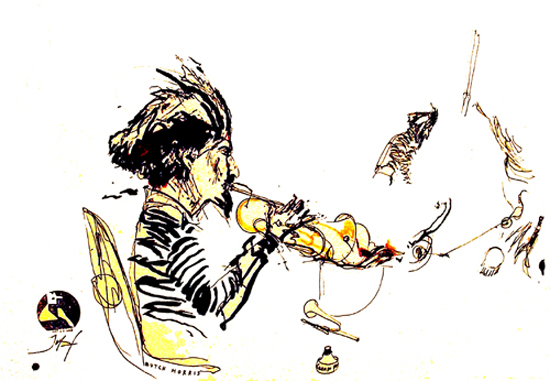
Cuando (Butch Morris Solo)—18 May 1985
Down on 2nd Street at Cuando in yet another long series of auditorium
concerts, you could have heard Butch Morris conductioning a solo cornet
recital with multiple hand signals modulating his own unique breathing.
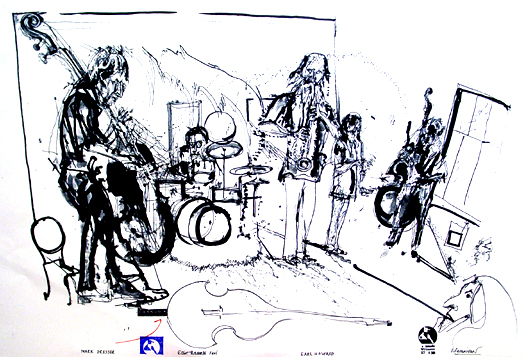
Afghanistan (Mark Dresser / Elliot Umberto Kavi / Earl Howard) @ Cuando—7
October 2001
Cut to October 2001: The World Trade Center demolition zone was casting
a pall... The bombardment of Afghanistan was just underway.
Arts for Art organized "From the Ashes," a massive exposition
of music concerts and art installations in the now derelict Cuando building
paralyzed by intersecting legal and political actions. Lights were hooked
up to an extension cord running in from outside. Citizen-Artist-Percussionist
Jackson Krall materialized out of the gloom with a dust mask, workgloves
and carrying tools.
Mark Dresser and Earl Howard sounded out their antidote at sunset. Then,
at nightfall, Joe McPhee came in with Trio-X to play a healing song of
aching beauty. For the last time, we filed down the dark stairs guided
by a tangled string of tiny multi-colored Christmas-tree lights.
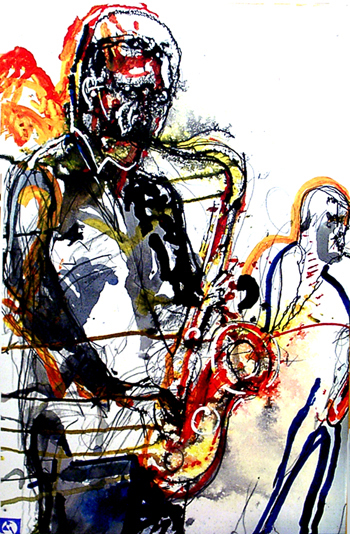
My Lady Sleeps [detail] (Joe McPhee & Trio-X)—same night
Simultaneously, uptown on Columbus Circle, the two massive towers of the
$1.7 Billion AOL Time Warner Center continued rising with a $115 Million
glass-curtained expanded showplace for Jazz @ Lincoln Center embedded
in its groin.
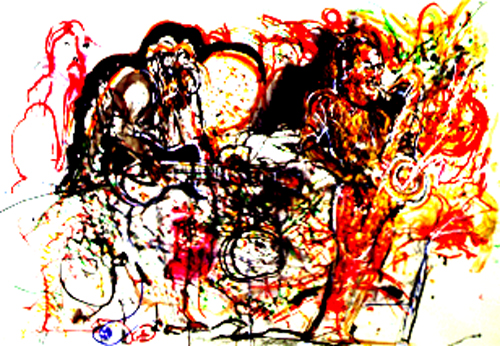
Below the Roots (James Blood Ulmer & David Murray)—28 May
2000
The legendary Electric Circus on St. Mark's Place with purple shag rug
on its curving wall was where the Chambers Brothers sang out "Time
!" in 1969. It was where the 5th Vision Festival built a stout platform
for James Blood Ulmer, David Murray and many others in the year 2000.
David declared, "The people need to hear Blood !"and at the
end of their set, Ray Bailey exclaimed, "Blood plays below the Roots."
The space, now a market for used furniture, is in transition to oblivion.
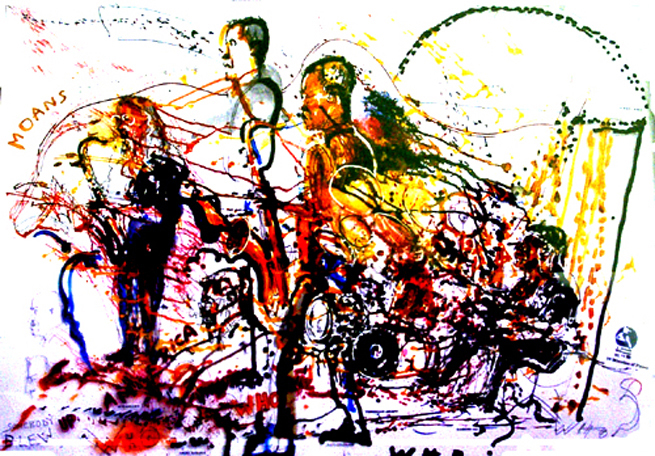
WHO ? ? ? ? ? ("75 minutes of Flame") @ Earl Hall—8
December 2001
Uptown at Columbia University, a unique event dedicated to the living
spirit of John Coltrane roared out with the power of dual horns, dual
drums and dual poets. Rashied Ali and Pheeroan AkLaff set the pace, Ravi
Coltrane and Mixashawn blew and Michael Rogers' strong words told the
story of Africa in America.
Then, Amiri Baraka, called up out of the audience, stood between the tenor
horns and before the massed drums demanding an answer. "Somebody
blew up America ! Who ? Who ?? Who ??? Who ???? WHO ????? "
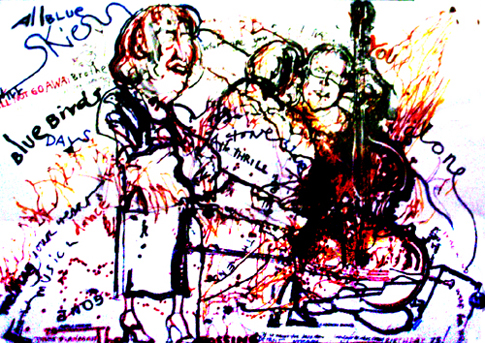
The Crossing (Sheila Jordan + Cameron Brown) @ Knitting Factory—26
November 2001
It was Sheila Jordan's 70th birthday celebration at the Knitting Factory
Main Space. The unamplified richness of Cameron Brown's bass was her eloquent
partner. Together they turned the awkward room for once into a beautifully
intimate singing party. Sheila Jordan's life in songs were dancing with
the deep, responsive strings, a musical story that filled everyone's ears
with an easy grace, swinging, bopping and real.
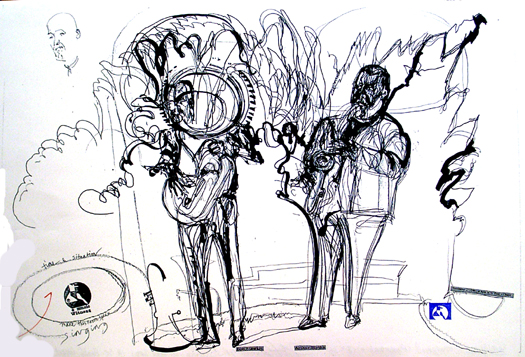
Singing (Bob Stewart + Arthur Blythe) @ St. Paul's Chapel—27 November
2001
St. Paul's Chapel on the Columbia campus is a beautiful work of classical
architecture with a magnificent brick-domed and columned interior. The
next night, two other masters who have interacted together for decades
adjusted their gorgeously flavored duo acoustics to kiss the warm masonry
surfaces without microphones, reflecting them back to the listeners ears
enhanced in a unique way, "making this room speak."
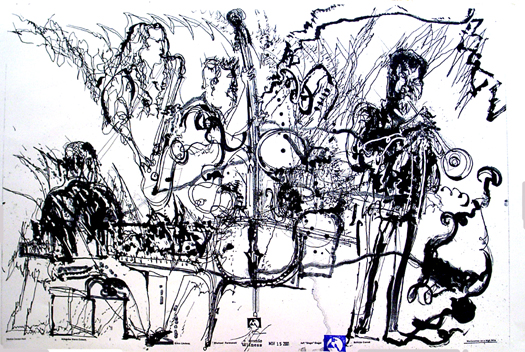
Marionettes (Baikida Carroll Quintet) @ Merkin Hall—15 November
2001
Just beyond Lincoln Center's northern border, a small, comfortable concert
venue is the home of the refreshing and varied Interpretations Series
produced by the World Music Institute & Thomas Buckner. Baikida Carroll
featured the honed and balanced live sound of compositions from his great
recording, Marionettes on a High Wire. Adegoke Steve Colson on
piano, Erica Lindsay on tenor, Michael Formanek, bass and Jeff Siegel,
drums merged and surged together with the force and brilliant complexity
of Carroll's trumpet. His group is a forward-sounding exemplar of an intense,
open and adventurous American beauty.
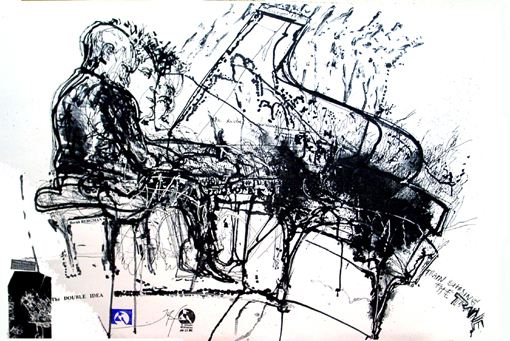
The Double Idea (Borah Bergman) @ Merkin Hall—10 January 2002
Interpretations opened its new year with a solo premiere performance of
The Double Idea by Borah Bergman. His unleashed left hand crossed
over the right and its "river of sound" for a while even passed
down the track of the Train that was chasing the Trane.
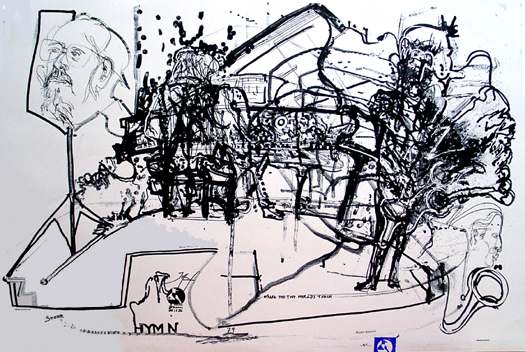
Stone Hymn 79 (Myra Melford + Marty Ehrlich) @ Merkin Hall—same
night.
Listening legend Irving Stone, now 79, was right there with his veteran
ears to hear Myra Melford's piano touch interact with Marty Ehrlich's
masterful reeds, Where the Two Worlds Touch.
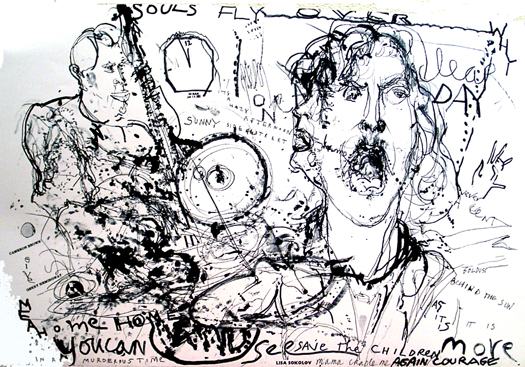
Again, Courage (Lisa Sokolov) @ 55 Bar—16 January 2002
Off Sheridan Square down in the heart of the West Village in a smoky local
hangout like the old days, there are semi-regular personal appearances
by the wonderful singer, Lisa Sokolov. Her vocal art, one part of William
Parker's music from its beginning, has the capacity to go anywhere with
confidence and surprise. Intimate with the flying movement of her lyric
sound, Cameron Brown is there again on bass, together with the infinitely
sensitive, heartfelt support of Gerry Hemingway on percussion.
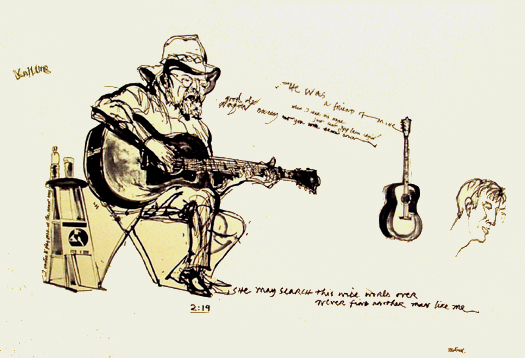
2:19 (Dave Van Ronk) @ Knitting Factory—5 February 2000
Dave Van Ronk, who may have played a thousand and one nights in Village
bars like the 55, "wanted to play jazz in the worst way" when
he started out. He became an exponent of the Jazz Blue Roots, developing
an authentic voice and attack to transmit the music of Lemon Jefferson,
Bukka White, Gary Davis, Louis Armstrong and other founders on to later
generations of northern City dwellers. He passed away on February 10th,
2002 at 65.
Here he is two years ago, opening for Odetta at the Knitting Factory,
his good humor overlaid with growling conviction, delivering the essence
of classic lines like "When I hear his name, just can't keep from
crying. He, was a friend of mine" and "You're a good old wagon,
daddy but you done broke down."
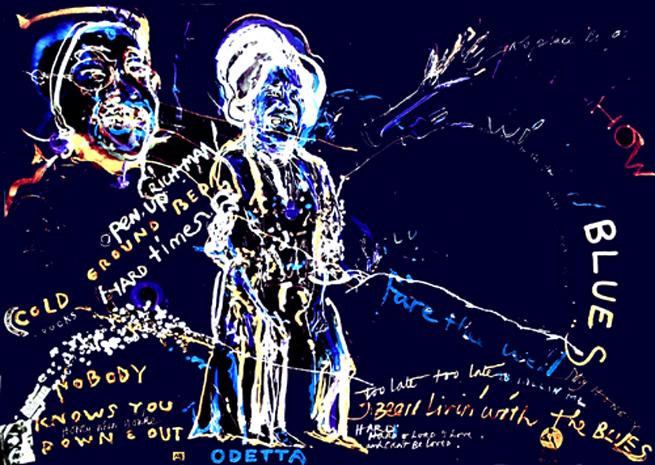
Hard Times (Odetta) @ Knitting Factory—5 February 2000
The thrill of real community in combination with individual human dignity
is the huge song of Odetta since her first appearance in New York at 19
in a brilliant red dress at Yugoslav Hall. She has been singing strong
Blues among her songs from the very beginning, often with great jazz musicians
and always with tremendous personal power. These days she has come to
a place where the spirits of Ma Rainey, Bessie Smith, Sippie Wallace and
Huddie Ledbetter have come together alive in her soul. The picture shows
a gathering of those deep spirit-sounds burning through the very beautiful
appearance of a woman in total contact with her listeners wearing, as
always, a gold pendant inscribed with the potent words, "(I AM)."
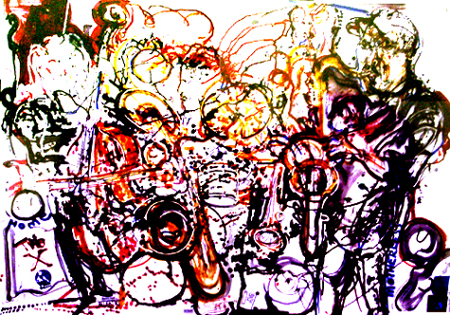
Motherless (Joe McPhee & Trio-X) @ Knitting Factory—1 February
2002
If you drop two floors from the Main Space, past the music Witness®
picture of Charles Gayle burning at the Old Knit on Houston Street in
1993 on the landing, on down to the sub-basement, you're in the Old Office
lounge. It is a low-ceilinged, dim room with a bar, a Trio at one end
and a long line of listeners stretching up the stairs at the other. Trio-X
was back in town. Motherless touched me deeply that night. Multiple dimensions
of Joe McPhee's live imagination are guaranteed get through to you on
many levels and time-frames. Its inspired play with Dominic Duval's bass
tones and Jay Rosen's panoramic percussion shakes you loose, opens you
up, renews and heals.
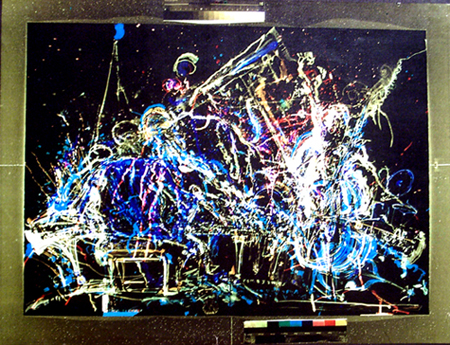
Chromosomes (Cecil Taylor Trio) @ Knitting Factory—8 January 1998
That same night Chromosomes, a 30 x 40" blue-black color print
which had been hanging in the Old Office for two years was lit up for
the first time. The last show Cecil Taylor played upstairs in the Main
Space was on a dark, cold winter night four years ago when the stage was
lit only by a few candles. Rose petals had been strewn across the broad
Boesendorfer keyboard. The sound intensities of his Trio introducing Dominic
Duval with Jackson Krall was recorded on 16 tracks and is still not yet
issued. You can see some of the living vibrations of that monumental performance
lingering on downstairs.
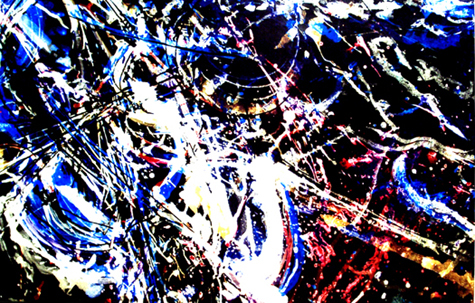
Chromosomes [detail]
A different exposition of that Trio sound was just offered in the second
half of Cecil Taylor's concert at Alice Tully Hall on February 28, 2002.
The whole tribe of dedicated, open-eared New York listeners were there
including the Stones, cool Ray, Pete, Harold, Yuko & Steve D, Bruce
Lee, MusicMargaret et al. together with a panoply of heavy, active musicians
in an enthusiastically filled house.
Taylor's voice chanted a brief opening while Duval's gleaming new bass
plucked harmonics and glowed. Krall's sticks rapped around the broad stage
floor and onto the stands and rims of his funky downtown Drums. Then they
settled in to open up the frequencies.
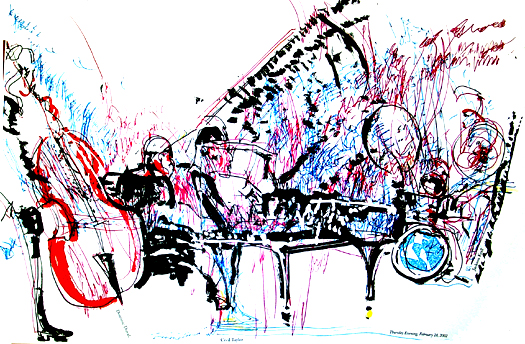
Cecil Taylor Trio (with Dominic Duval & Jackson Krall)—28
February 2002
But in the first half of the evening, our reigning master of inimitability
appears out of the left wing chanting "ILA vratta to a circle among
Egyptians," glides on long rainbow-colored socks to the open Steinway,
sects out the pages of his extensive written score and launches into "An
Ascending Axis" solo, "relating to plants and stems of plants."
The panoramic dynamic range of Taylor's keyboard dance builds and projects
a unique hailstorm resonance of color-string vibrations. The wide open
wood space of Tully Hall becomes transformed into the interior of a vast
and resonant piano; ringing, vivid, challenging, extensively poetic.
Then the people are standing, bringing all hands together in shared appreciation
of the uniquely charged moment. A hush falls, a reappearance. A brief,
glittering extemporaneous response is touched, a liquid warble of haiku,
a sonic flower left in all those ears.
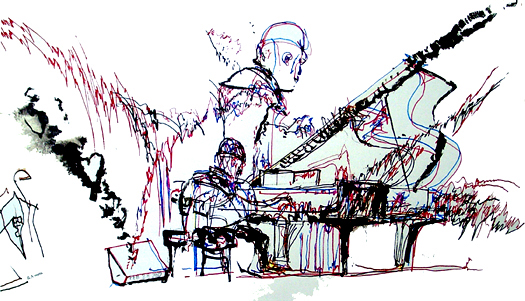
ILA (Cecil Taylor Solo) NAN
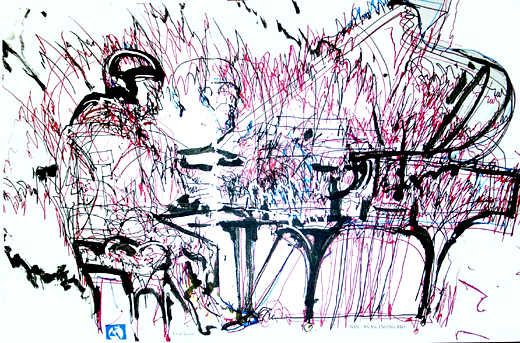
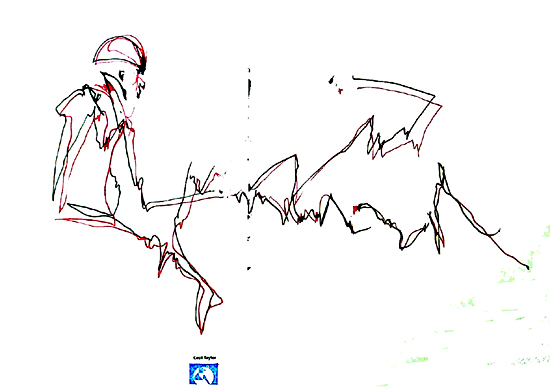
Haiku (encore)
